 Microsoft co-founder Paul Allen and his underwater research team have discovered the wreck of the Imperial Japanese Navy’s World War II battleship Musashi. Musashi was the second of three Yamato class ships, the heaviest and most armed battleships ever constructed. The ship went down in the Battle of the Sibuyan Sea, an engagement of the Battle of Leyte Gulf, the largest naval battle of World War II, on October 24th, 1944. The Sibuyan Sea is between the Visayan Islands and the island of Luzon in the Philippines, so the general area where the ship went down was known, but even with numerous extant eyewitness accounts of the battle, the shipwreck’s precise location was unknown. The wreck of Musashi‘s older sister ship Yamato, sunk in August of 1945, was found in 1982 leaving Musashi the largest of history’s undiscovered shipwrecks.
Microsoft co-founder Paul Allen and his underwater research team have discovered the wreck of the Imperial Japanese Navy’s World War II battleship Musashi. Musashi was the second of three Yamato class ships, the heaviest and most armed battleships ever constructed. The ship went down in the Battle of the Sibuyan Sea, an engagement of the Battle of Leyte Gulf, the largest naval battle of World War II, on October 24th, 1944. The Sibuyan Sea is between the Visayan Islands and the island of Luzon in the Philippines, so the general area where the ship went down was known, but even with numerous extant eyewitness accounts of the battle, the shipwreck’s precise location was unknown. The wreck of Musashi‘s older sister ship Yamato, sunk in August of 1945, was found in 1982 leaving Musashi the largest of history’s undiscovered shipwrecks.
Paul Allen being a billionaire and a history nerd with a particular fascination for World War II, put together a team of researchers eight years ago with the goal of finding the elusive giant. They scoured historical records from four countries and deployed the latest and greatest technology to survey the floor of the Sibuyan Sea. The multi-beam bathymetric survey of the seafloor didn’t find the wreck, but it did allow the team to eliminate large areas from the search and, on a cool oceanographic note, identified five previously unknown geographic features.
 In February of this year, Allen and his team took his superyacht M/Y Octopus equipped with submersible vehicles to search underwater for the wreck. They first deployed an Autonomous Underwater Vehicle (AUV). Thanks to the survey’s elimination of large swaths of the area, the AUV found the wreck on the third dive on March 2nd, 2015. Researchers then sent a Remote Operated Vehicle (ROV) with an HD camera to explore the wreck and find identifying features. It was a valve wheel that provided the first confirmation that the wreck was of a Japanese ship. It had Kanji on it that read “open” and “main valve handle.”
In February of this year, Allen and his team took his superyacht M/Y Octopus equipped with submersible vehicles to search underwater for the wreck. They first deployed an Autonomous Underwater Vehicle (AUV). Thanks to the survey’s elimination of large swaths of the area, the AUV found the wreck on the third dive on March 2nd, 2015. Researchers then sent a Remote Operated Vehicle (ROV) with an HD camera to explore the wreck and find identifying features. It was a valve wheel that provided the first confirmation that the wreck was of a Japanese ship. It had Kanji on it that read “open” and “main valve handle.”
 Japanese warships didn’t have their names written on their sides, so identifying the Musashi requires an accumulation of circumstantial evidence and it’s challenging because the ship, which went down whole, apparently exploded at least once underwater. There’s a vast debris field 2,600 feet by 1,640 feet wide with pieces of the ship scattered all around. They found the mount for the teak chrysanthemum, the Imperial Seal of Japan, on the bow, the teak flower long since rotted away, and a catapult used to launch the six or seven float planes the Musashi carried. They also found the main gun turret mount and beneath it damage from US torpedoes that matched the known hits.
Japanese warships didn’t have their names written on their sides, so identifying the Musashi requires an accumulation of circumstantial evidence and it’s challenging because the ship, which went down whole, apparently exploded at least once underwater. There’s a vast debris field 2,600 feet by 1,640 feet wide with pieces of the ship scattered all around. They found the mount for the teak chrysanthemum, the Imperial Seal of Japan, on the bow, the teak flower long since rotted away, and a catapult used to launch the six or seven float planes the Musashi carried. They also found the main gun turret mount and beneath it damage from US torpedoes that matched the known hits.
On March 13th, Paul Allen and the Musashi Expedition team sent the ROV back down to explore the wreck and released a live feed of the video on the Internet. The quality of the footage is amazing at 3,280 feet below the surface, and even though the ship is torn to bits, you can still see just how massive it was.
[youtube=https://youtu.be/jwaaJeCjgjw&w=430]
One of the viewers of the live feed doesn’t need to wait for official confirmation to know it’s the wreck of the Musashi.
Also watching the feed in Japan was 94 year-old Shigeru Nakajima, one of those who survived the Japanese battleship’s sinking. He said he was certain the wreckage was that of the ship he was aboard 71 years ago when it was sunk by U.S. forces. [..]
“I am certain that this is the Musashi by now looking at the images such as the anchor, the imperial seal of the chrysanthemum,” Nakajima told the Associated Press as he watched the video.
Nakajima was an electrical technician for the sub battery on the vessel. He survived the torpedo attack by jumping into the water as he was ordered to evacuate by his senior officer.
Nakajima, who became the chef at the U.S. Embassy in Tokyo after the war, said he had no words but “thank you” for the team that found the wreckage, adding that the ship’s captain Toshihira Inoguchi and other crew members who perished “must be delighted to hear this news… in heaven.”
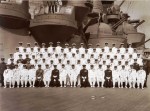 As large (862 feet long displacing 72,800 tonnes at full load), powerful and armed to the teeth as the Musashi was (it had 18-inch armor plating and nine 18-inch Type 94 main guns, the largest calibre guns ever mounted on a warship), the ship saw limited engagement during the war. She had suffered significant damage after being torpedoed by the submarine USS Tunny in Palau on March 29th, 1944, but two weeks of repair work fixed the 19-foot hole and new anti-aircraft armament was added.
As large (862 feet long displacing 72,800 tonnes at full load), powerful and armed to the teeth as the Musashi was (it had 18-inch armor plating and nine 18-inch Type 94 main guns, the largest calibre guns ever mounted on a warship), the ship saw limited engagement during the war. She had suffered significant damage after being torpedoed by the submarine USS Tunny in Palau on March 29th, 1944, but two weeks of repair work fixed the 19-foot hole and new anti-aircraft armament was added.
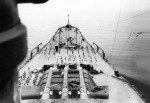 On October 22th, both the Musashi and the Yamato along with the main Japanese fleet were deployed to Leyte in the Philippine where American forces, including General Douglas MacArthur who famously declared “I have returned” when he came ashore, had landed on the island on October 20th, 1944. The fleet was spotted by a US aircraft at 8:10 AM on October 24th, 1944. Just over two hours later, 30 American planes were heading for it, focusing their attack on Musashi.
On October 22th, both the Musashi and the Yamato along with the main Japanese fleet were deployed to Leyte in the Philippine where American forces, including General Douglas MacArthur who famously declared “I have returned” when he came ashore, had landed on the island on October 20th, 1944. The fleet was spotted by a US aircraft at 8:10 AM on October 24th, 1944. Just over two hours later, 30 American planes were heading for it, focusing their attack on Musashi.
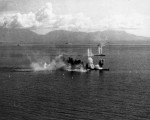 The Japanese fleet did not have sufficient air cover to defend against the American planes. Musashi used its anti-aircraft guns to create a canopy of flak over the fleet and shot its Type 94 guns into the water to create geysers massive enough to take down American bombers. It’s a testament to how powerful those guns were that the tactic almost worked. TBF Avenger pilot Ensign Jack Lawton described them thus: “Running into one of these geysers would be like running into a mountain. I felt the muzzle blast each time they fired. I could swear the wings were ready to fold every tie these huge shockwaves hit us.”
The Japanese fleet did not have sufficient air cover to defend against the American planes. Musashi used its anti-aircraft guns to create a canopy of flak over the fleet and shot its Type 94 guns into the water to create geysers massive enough to take down American bombers. It’s a testament to how powerful those guns were that the tactic almost worked. TBF Avenger pilot Ensign Jack Lawton described them thus: “Running into one of these geysers would be like running into a mountain. I felt the muzzle blast each time they fired. I could swear the wings were ready to fold every tie these huge shockwaves hit us.”
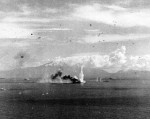 It wasn’t enough to counter the battering they were getting from the air, or from under the sea, for that matter. Over the course of the afternoon, the Musashi was attacked by wave after wave of bombs and torpedoes. The final attack ended at 3:30 PM. By then 19 torpedoes and 17 bombs had torn through her and she was in very bad shape. Moving north with a heavy cruiser and two destroyers escorting her, she got slower and slower, began to list to starboard and was increasingly down by bow as her hull took on more and more water. Attempts to correct the list failed.
It wasn’t enough to counter the battering they were getting from the air, or from under the sea, for that matter. Over the course of the afternoon, the Musashi was attacked by wave after wave of bombs and torpedoes. The final attack ended at 3:30 PM. By then 19 torpedoes and 17 bombs had torn through her and she was in very bad shape. Moving north with a heavy cruiser and two destroyers escorting her, she got slower and slower, began to list to starboard and was increasingly down by bow as her hull took on more and more water. Attempts to correct the list failed.
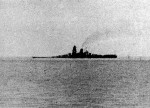 When the list reached 12 degrees at 7:15 PM, Musashi‘s commander Vice Admiral Toshihira Inoguchi gave the standby to abandon ship order and retired to his cabin where he would go down with the Musashi. The list reached 30 degrees at 7:30 and the order to abandon ship was given. The Musashi capsized and sank at 7:36 PM. Although more than half of the crew was rescued, a staggering 1,023 people died aboard Musashi, including Inoguchi, out of a crew of 2,399.
When the list reached 12 degrees at 7:15 PM, Musashi‘s commander Vice Admiral Toshihira Inoguchi gave the standby to abandon ship order and retired to his cabin where he would go down with the Musashi. The list reached 30 degrees at 7:30 and the order to abandon ship was given. The Musashi capsized and sank at 7:36 PM. Although more than half of the crew was rescued, a staggering 1,023 people died aboard Musashi, including Inoguchi, out of a crew of 2,399.